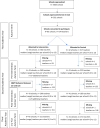Effectiveness of universal school-based mindfulness training compared with normal school provision on teacher mental health and school climate: results of the MYRIAD cluster randomised controlled trial
- PMID: 35820990
- PMCID: PMC9340006
- DOI: 10.1136/ebmental-2022-300424
Effectiveness of universal school-based mindfulness training compared with normal school provision on teacher mental health and school climate: results of the MYRIAD cluster randomised controlled trial
Abstract
Background: Education is broader than academic teaching. It includes teaching students social-emotional skills both directly and indirectly through a positive school climate.
Objective: To evaluate if a universal school-based mindfulness training (SBMT) enhances teacher mental health and school climate.
Methods: The My Resilience in Adolescence parallel group, cluster randomised controlled trial (registration: ISRCTN86619085; funding: Wellcome Trust (WT104908/Z/14/Z, WT107496/Z/15/Z)) recruited 85 schools (679 teachers) delivering social and emotional teaching across the UK. Schools (clusters) were randomised 1:1 to either continue this provision (teaching as usual (TAU)) or include universal SBMT. Data on teacher mental health and school climate were collected at prerandomisation, postpersonal mindfulness and SBMT teacher training, after delivering SBMT to students, and at 1-year follow-up.
Finding: Schools were recruited in academic years 2016/2017 and 2017/2018. Primary analysis (SBMT: 43 schools/362 teachers; TAU: 41 schools/310 teachers) showed that after delivering SBMT to students, SBMT versus TAU enhanced teachers' mental health (burnout) and school climate. Adjusted standardised mean differences (SBMT minus TAU) were: exhaustion (-0.22; 95% CI -0.38 to -0.05); personal accomplishment (-0.21; -0.41, -0.02); school leadership (0.24; 0.04, 0.44); and respectful climate (0.26; 0.06, 0.47). Effects on burnout were not significant at 1-year follow-up. Effects on school climate were maintained only for respectful climate. No SBMT-related serious adverse events were reported.
Conclusions: SBMT supports short-term changes in teacher burnout and school climate. Further work is required to explore how best to sustain improvements.
Clinical implications: SBMT has limited effects on teachers' mental and school climate. Innovative approaches to support and preserve teachers' mental health and school climate are needed.
Keywords: Child & adolescent psychiatry; Depression & mood disorders.
© Author(s) (or their employer(s)) 2022. Re-use permitted under CC BY. Published by BMJ.
Conflict of interest statement
Competing interests: WK is the Director of the Oxford Mindfulness Centre and receives royalties for several books on mindfulness. JMGW is former Director of the Oxford Mindfulness Centre and receives royalties for several books on mindfulness.
Figures


References
-
- Zins J, Elias M, Greenberg M. Facilitating success in school and in life through social and emotional learning. Perspectives in Education 2003;21:55–67.
-
- Wang M-T, Degol JL. School climate: a review of the construct, measurement, and impact on student outcomes. Educ Psychol Rev 2016;28:315–52. 10.1007/s10648-015-9319-1 - DOI
Grants and funding
LinkOut - more resources
Full Text Sources
